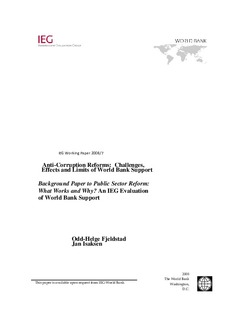| dc.contributor.author | Fjeldstad, Odd-Helge | |
| dc.contributor.author | Isaksen, Jan | |
| dc.date.accessioned | 2018-01-04T08:21:11Z | |
| dc.date.issued | 2008-09-01 | |
| dc.identifier | oai:www.cmi.no:3134 | |
| dc.identifier.citation | Washington DC: Independent Evaluation Group (IEG), World Bank (IEG Working Paper no. 7) 78 p. | |
| dc.identifier.isbn | 13: 978-1-60244-096- | |
| dc.identifier.isbn | 13: 978-1-60244-096- | |
| dc.identifier.uri | http://hdl.handle.net/11250/2475182 | |
| dc.description.abstract | This study compares the evolution of the state-of-the-art in research and analysis of anticorruption and transparency with World Bank practice. The first part of the paper reviews the theoretical and empirical approaches that have influenced the World Bank's and the donor community's thinking on how to diagnose and fight corruption. Also covered are interventions and diagnostic tools that have been developed to improve governance and assess corruption, as well as recent Bank-supported international initiatives to curb grand corruption. Thereafter, the paper analyzes experiences from the Bank's engagement in anti-corruption, drawing on the results of 19 country case studies covering developing and transitional countries. From the country cases it appears that anti-corruption measures are too often proposed by the Bank without considerations of the political economy and without clear strategies to win the support of a critical mass of key leaders who would help overcome the inevitable opposition of vested interests.
Evidence from the country cases are used to highlight past pitfalls and propose directions for future support to governance and anti-corruption reforms. First, the Bank needs to do more to understand corruption in the particular country context. The priorities for anticorruption efforts need to be based on an assessment in each country of the types of corruption most harmful to development. Second, direct measures to reduce corruption, such as the establishment of anti-corruption commissions, rarely succeed since they often lack the required support from political elites and the judicial system. Third, linking governance work with visible public service improvements may help build the credibility of reforms as from the point of view of citizens and government. Fourth, sustaining efforts to reduce corruption have better prospects when they emphasize making information public and building systems to reduce the opportunities for corruption.
This study | |
| dc.language.iso | eng | |
| dc.publisher | Independent Evaluation Group (IEG), World Bank | |
| dc.relation | IEG Working Paper | |
| dc.relation | 7:2008 | |
| dc.relation.ispartof | IEG Working Paper | |
| dc.relation.ispartofseries | IEG Working Paper 7:2008 | |
| dc.relation.ispartofseries | IEG Working Paper 7:2008 | |
| dc.relation.uri | https://www.cmi.no/publications/3134-anti-corruption-reforms-challenges | |
| dc.subject | Anti-Corruption | |
| dc.subject | Corruption | |
| dc.subject | World Bank | |
| dc.title | Anti-corruption Reforms: Challenges, Effects and Limits of World Bank Support | |
| dc.type | Research report | |
| dc.identifier.cristin | 1678164 | |
